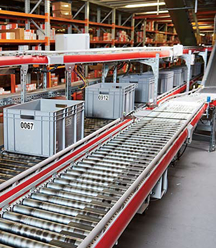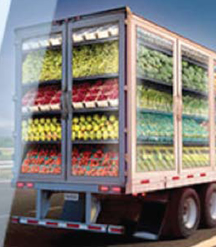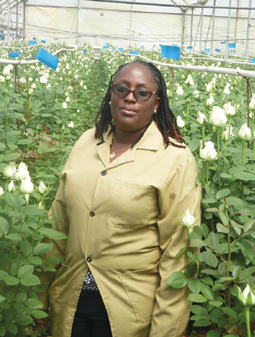Featured Past Articles
 This year’s Valentines Day and mother’s Day million’s of consumer’s bought flowers. It’s peak for florists, anticipating to bring billions of dollars to the floral market.
This year’s Valentines Day and mother’s Day million’s of consumer’s bought flowers. It’s peak for florists, anticipating to bring billions of dollars to the floral market.
While it’s easy for customers to pick up flowers at the local grocery store, florist shop or to seamlessly order arrangements online, not surprisingly there’s up to a year of forecasting and planning for what one representative from online flower delivery company calls a “last-minute holiday.”
Don’t underestimate the importance of these days to the floral industry. The biggest floral holidays are Valentine’s Day and Mother’s Day, but Valentine’s Day is a big percentage of yearly sales.
High volume, perishable products, fickle winter weather and long transportation routes means that the supply chain must be working smoothly to get the fresh flowers in the customers’ hands at the right time.
The cold chain
Lovebirds around the world can thank the cold chain for allowing them to adorn their tables with blooming buds every February, and actually all year round. That’s because most of the flowers sold come from abroad. The main domestic floral producers, accounts for only a small percentage of the flowers, though these flowers too must be maintained in the proper environment for quality purposes. The rest of the flowers primarily come from South America and Africa.
Read more: The Hidden Supply Chain Behind Valentine’s Day Flowers
 IFTEX has traditionally been a very popular exhibition to market your products, services and business. With advances in social media marketing and Internet technology, like webinars, Google hangouts and video conferencing, the value and benefits of marketing via trade fair comes up. Though technology is changing marketing at a rapid pace, there are several benefits from having exhibit presence at a trade show. These six key benefits are why your business must have IFTEX Exhibition marketing presence:
IFTEX has traditionally been a very popular exhibition to market your products, services and business. With advances in social media marketing and Internet technology, like webinars, Google hangouts and video conferencing, the value and benefits of marketing via trade fair comes up. Though technology is changing marketing at a rapid pace, there are several benefits from having exhibit presence at a trade show. These six key benefits are why your business must have IFTEX Exhibition marketing presence:
1.IFTEX Creates Lasting Impressions If Done Right
The main purpose of IFTEX is to showcase a wide variety of options for attendees and business to engage and interact with each other. With a well-designed trade show booth that draws attendees’ attention, a few promotional items, a contest opportunity with giveaways and sales collateral, you will have a well-rounded booth experience that leaves an impression with a prospective customer for months. Consider having attendees enter a drawing by submitting a business card or completing an action on social media. These types of promotions serve dual purposes: increasing engagement and capturing potential contact information as well.
Read more: Six Key Benefits IFTEX Show Has to Market Your Business
The Seven Critical Steps To a Successful Warehouse Automation
Retailers are turning their attentions to warehouse automation. The reasons may be all too apparent, but the path to a successful project is not so obvious, writes Neil Adcock.
 Why are omnichannel retailers suddenly taking an interest in automating their warehouses? Until very recently the retail sector had tended to shy away from making such investments, preferring instead to take on a large labour force to manually process orders. However, that thinking appears to be changing – and rapidly so.
Why are omnichannel retailers suddenly taking an interest in automating their warehouses? Until very recently the retail sector had tended to shy away from making such investments, preferring instead to take on a large labour force to manually process orders. However, that thinking appears to be changing – and rapidly so.
A number of leading retail brands are now actively engaged in adopting high levels of automation. The reasons are clear to see, but the right approach needs to be taken if agility and operational performance are to be leveraged to full advantage.
Several significant factors have come into play to alter the balance between the use of man or machine. Firstly, shoppers are shifting online in a big way. The Office for National Statistics estimate that consumers spent £1bn a week with UK online retailers, up 20.7 percent. Internet shopping now accounts for 15.3 percent of all retail spending.
This massive and continuing growth in online purchases, with its requirement for single item picking, packing and dispatch, as well as increasing SKU proliferation, has placed a huge strain on finite labour resources in the all-important logistics hot spots. Even outside these areas, the pool of available labour is diminishing fast. The introduction of the National Living Wage has also significantly increased costs for highly staffed operations.
Brexit is another factor weighing heavily on the minds of those managing labour intensive operations. The big question is, will the availability of cheap labour from Europe ebb away in the wake of tighter border controls and the lacklustre appeal of a weaker currency? Then there are the competitive pressures within the market place.
Read more: The seven Critical Steps To a Successful Warehouse Automation
By Luke Gowdy
 It bothers me that poor cold chain management leads to so much fresh produce being thrown out before it even hits the shelf. During a Supply Chain Conference presentation, It was explained that it doesn’t have to be that way. You can use these 6 key concepts to build a better cold chain and reduce waste.
It bothers me that poor cold chain management leads to so much fresh produce being thrown out before it even hits the shelf. During a Supply Chain Conference presentation, It was explained that it doesn’t have to be that way. You can use these 6 key concepts to build a better cold chain and reduce waste.
1. Secure the right expertise
Cold chains require trained temperature controlled specialists even before the product is picked up. Specialists who understand both temperature requirements of the shipment and who have a strong working relationship with the shipper and carrier can help balance unattractive load qualities like multi-pick, multi-stop loads by filling empty backhauls.
2. Determine capacity requirements
Whether transporting temperature sensitive goods by road, ocean, air, or rail, you’ll need to carefully consider the pros, cons, and price—especially when coordinating across multiple types of transportation. Some commodities—those with higher price points—can benefit from a more expensive, yet faster shipping option.
3. Set clear expectations early in the process
If a trailer’s temperature increases by only 2 degrees Fahrenheit, it can reduce produce shelf life by as much as 50%. That’s why the shipper, carrier, vendor, provider, and other key stakeholders must agree on their roles—from acceptable temperature ranges and continuous temperature versus cycle settings, to proper seals, contingency plans, equipment expectations, and processes for returns and rejections.
Switching to a different form of applied nitrogen could increase grower profits, improve plant physiology and raise plants’ stress tolerance, according to new research
By Adrian Bell
The alternative nitrogen – a chemically stabilised form of urea – would also optimise resource use while helping to reduce the environmental impact of fertiliser manufacture, according to British firm Levity Crop Science, which carried out the study on a range of containerised ornamentals.
“Plant development altered favourably and improved several commercial attributes, such as more branches and flowers, while raising tolerance to stress caused by drought or transplantation,” says David Marks, one of the study’s co-authors.
The findings, published in the Journal of Horticulture and Postharvest Research, suggest growers could make more efficient use of nitrogen fertiliser and produce healthier, more desirable plants by applying it in a more accessible form.
Growers preparing their thrips spray programs will have many options including Sivanto prime from Bayer CropScience and distributed by Elgon Kenya Ltd in the region. It was Pomp and dance as growers welcomed the latest insecticide from Bayer CropScience for the control of sucking insects. The new butenolide chemistry makes Sivanto Prime systemic insecticide that can be used to control wide range of sucking insects, such as aphids, whiteflies, thrips and other important pests.
 What is Sivanto Prime?
What is Sivanto Prime?
Sivanto Prime is the latest insecticide from Bayer Crop Science for the control of important sucking insects that fits perfectly in sustainable growing systems. Sivanto Prime protects your crop against a wide range of insects, such as whiteflies, aphids, and thrips and is effective against both nymphs / larvae and adult stages. Sivanto Prime has a fast activity and is absorbed by the leaf, after which the active substance moves in the direction of the juice flow. Also key, the mode of action of the active substance flupyradifurone, makes Sivanto Prime an asset in resistance management strategies.
What is the mechanism of action of Sivanto Prime?
Sivanto Prime works in the central nervous system of the insect as an agonist of the nicotinic acetylcholine receptor (nAChR) of the insect. The active substance flupyradifurone mimics the natural neurotransmitter. The long-lasting effect of the product results in a disorder of the nervous system of the insect,and subsequent death.
What makes Sivanto Prime unique?
Sivanto Prime has a very fast effective control against sucking insects and a favorable profile. Sivanto Prime gives effective vector control through fast activity and feeding ceasation in insects.
How is Sivanto Prime classified in the IRAC mode of action group? The Insecticide Resistance Action Committee (IRAC) has classified Sivanto Prime, (flupyradifurone), in the new subgroup 4D - Butenolides, a new subgroup of Group 4, which includes all insecticidal agonists of the nicotinic acetylcholine receptor (nAChR).
Concisely describe Christine Karambu
Christine is an agronomist and administrator with vast experience in the floriculture sector for over 18 years. The JKUAT graduate in horticulture who later on studied Business Administration, majoring in HR at KEMU holds several certifications gained during her professional path. She holds, among others FACTS; an international Fertilizer Recommendation course offered by BASIS and Women in Leadership by Strathmore University. Over the years, she has progressed through the ranks from a junior supervisor to her current level of senior management.
 What spurred you into growing? Any role model who inspired you?
What spurred you into growing? Any role model who inspired you?
In all honesty, I never thought this would be my career path. I grew up in a family that did large scale farming: my parents retired from their professions to exclusively focus on farming. I did not have interest then, until I joined high school and started feeling the touch. My interest grew as I watched my parents address and train students from colleges and other institutions of higher learning. Through the results of my hard work, as well as the multiple challenges I faced on my journey, my inspiration grew exponentially, to the point where I firmly knew my interest lay in the industry.
Kindly take us through your journey as a grower to your current position.
I have been in the floriculture sector for a total of 18 years. As you can see, I’m no spring chicken in the field. After college, I began my journey in (the former) Kijabe Limited as a supervisor and then joined 3 other companies as I rose through the ranks. I’m presently at the Oserian Development Company, as a senior grower, and I’ve been here for the last four years and counting. In addition to this, I over-see the company’s Research and Development unit.
Briefly discuss the challenges you go through daily? What would you point out as your strongest attribute that has made you succeed? How do you rise up to the greatest challenge that your job presents?
Growing presents different challenges every day: the weather patterns are unpredictable, pests and diseases are always piling on pressure and the market trends are typically volatile. Early on, I struggled with numerous, varied challenges. I’ll admit to that much. But rather than get cowed and give up, I chose to adapt and grow. This helped me internalize one of my most valuable lessons: every challenge has a solution; you just have to think outside the box sometimes. I have learned the value of self-motivation, constant research to stay ahead, lots of consultation and taking one day at a time. I have learned that each day, at the very least, presents a learning opportunity or two. My job also requires that I motivate others; I really have no window for dullness or giving up. For the sake of my staff and the projects I am at the helm of, I have to be perpetually motivated. To lead properly, I have to actually listen, as opposed to just hearing things.


